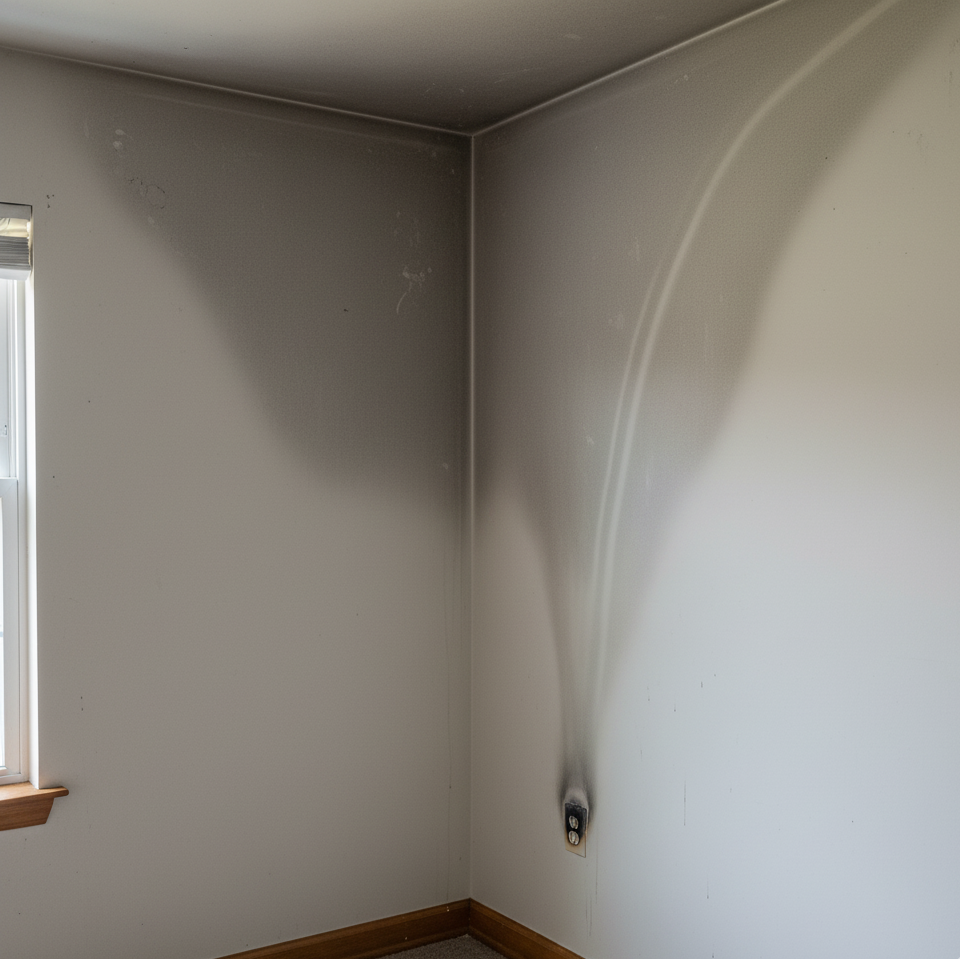After a fire, soot residue is often the most dangerous thing left behind. It spreads fast, hides in small spaces, and keeps damaging your home long after the flames are gone. The burned walls. The smell. The mess. But the biggest problem is what’s left once the smoke clears. That black, powdery dust on your walls and vents might look harmless, yet it’s one of the most toxic and damaging things inside a home after a fire.
What Exactly Is Soot?
Soot is made of tiny carbon particles that form when materials like wood, fabric, or plastic don’t burn completely. Each particle carries chemicals, acids, and even heavy metals. Once the fire is out, those particles float through the air and settle on every surface they can reach. They stick to paint, fabric, furniture, and anything porous.
Even if the fire only affected one room, soot can travel through your HVAC system and reach every corner of the home. It might leave a greasy film on walls or a faint odor that just won’t go away. Ordinary cleaning supplies only smear it around, making the stains worse.
How Soot Affects Your Health
Soot doesn’t just look bad. It also makes the air inside your home unsafe to breathe. The particles are so fine that they can get deep into your lungs and bloodstream. That can cause coughing, headaches, eye irritation, and chest tightness. For kids, older adults, or anyone with asthma, it can be even more serious.
The Environmental Protection Agency warns that fine soot particles (PM2.5) are directly linked to long-term heart and lung damage, including heart attacks and respiratory effects. You may not even smell them, but the air can be full of these irritants for days or weeks. If soot settles on bedding or furniture, it can trigger skin irritation or allergies too. Until it’s removed correctly, it’s not safe to live in. Learn more from EPA.
The Damage Soot Does to Your Home
Soot doesn’t just sit there. It reacts with what it touches. Within hours, it can discolor walls, pit chrome, and dull appliances. Glass, metal, and plastic all start to corrode. That faint yellowing you see on walls after a small fire is the acid from soot doing its work.
If soot gets into the ductwork, every time your HVAC system runs it spreads the residue again. That means more surfaces get coated and the air keeps circulating with microscopic debris. Professional restoration companies like Emergency Restoration Xperts (ERX) use air scrubbers and containment barriers to stop that cycle before cleaning even starts.
Why You Shouldn’t Try to Clean It Yourself
A lot of people grab a sponge and go to work right away. It feels productive, but it almost always causes more damage. Regular household vacuums don’t have HEPA filters, and wiping soot with water or all-purpose cleaners can stain walls permanently.
Restoration techs use dry-cleaning sponges and special neutralizing agents that lift the soot without grinding it deeper. They also check which materials can be salvaged and which need replacement. The difference between doing it yourself and hiring a pro can be the difference between saving your drywall or having to tear it out later.
How Professionals Remove Soot Safely
Here’s what a real fire cleanup usually looks like when handled by certified pros:
- Inspect and isolate the damaged area to stop soot from spreading.
- Run HEPA air scrubbers to pull contaminants out of the air.
- Dry clean surfaces with specialized sponges before any moisture is used.
- Neutralize acids with professional-grade cleaning solutions.
- Deodorize the home with thermal fogging or ozone treatment if needed.
- Check air quality before the area is considered safe again.
Each step protects your home from corrosion, odor, and recurring contamination. It’s careful work that requires both training and the right tools.
Soot may look like simple dust, but it’s one of the most damaging parts of a fire. It keeps working long after the flames go out, quietly wearing down surfaces and filling the air with irritants. The sooner it’s cleaned the right way, the less you’ll spend fixing corrosion, odors, or health issues later.
If soot or smoke has entered your living space, don’t wait or guess about safety.
Emergency Restoration Xperts (ERX) is available 24/7 for certified fire cleanup, soot removal, and odor restoration. Call anytime at (828) 639-8208 to schedule immediate help and restore your home the right way.


